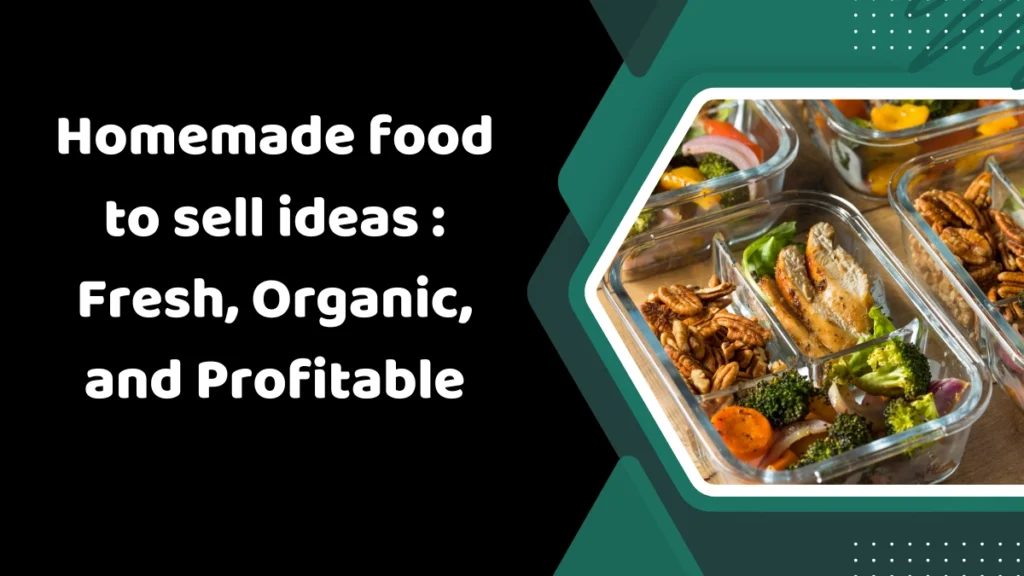Do you want to know about Homemade food to sell ideas ? Then this article is just for you.
Fresh Ideas for Your Business In today’s health-conscious world, many people want food that’s not only delicious but also nutritious, clean, and sustainably sourced.
Selling homemade organic food is a wonderful way to meet this demand while turning your passion for cooking into a business.
So today, I will discuss Homemade food to sell ideas in detail for your convenience.
Also, I will discuss the things that need to be paid attention to in order to do business.
So that you don’t face any problem. For this you have to read all the articles.

Homemade food to sell ideas
Here are some popular homemade organic food ideas that can be made from your kitchen and sold locally or online.
1.Organic Baked Goods
Organic baked goods, like bread, muffins, cookies, and cakes, are always in demand.
Many people prefer organic versions of these treats because they are free of artificial additives and preservatives. Consider offering options like:
- Whole-grain bread made with organic flours.
- Gluten-free or vegan options to cater to dietary needs.
- Seasonal fruit muffins or pies, using fresh, locally sourced produce.
- Low-sugar cookies or bars that use natural sweeteners like honey or maple syrup.
Packaging Tip:
Use biodegradable or compostable materials for packaging. Brown kraft paper or cardboard boxes with minimal plastic are ideal and align with the organic, eco-friendly appeal of your brand.
2. Homemade Sauces, Spices, and Condiments
Many people love having a stock of sauces, dips, and seasonings at home for easy meals.
Making and selling organic condiments can give your customers a healthier alternative to store-bought products that may contain preservatives. Some ideas include:
- Tomato or pesto sauces with organic herbs and vegetables.
- Chili sauce or salsa, perfect for adding a kick to meals.
- Herb-infused oils or vinegar for salad dressings.
- Spice mixes for specific cuisines, like Italian or Indian dishes.
Packaging Tip:
Glass jars with minimalistic labels that detail the ingredients add a rustic, high-quality feel to your products. Consider offering a returnable jar program for a sustainable option.
3. Fresh Organic Juices and Smoothies
Organic juices and smoothies are popular among health enthusiasts.
These drinks are nutrient-rich, refreshing, and can be offered in unique flavors. Consider making:
- Cold-pressed fruit and vegetable juices for a nutrient boost.
- Superfood smoothies with ingredients like chia seeds, spirulina, or kale.
- Seasonal fruit blends for different times of the year, such as pumpkin spice smoothies in fall or berry blends in summer.
Packaging Tip:
Use recyclable glass bottles or compostable cups. Clearly label each drink with its ingredients, calorie count, and a note on whether it’s vegan or gluten-free.
4. Organic Baby Food
Many parents seek organic, homemade baby food options that are free from preservatives, artificial flavors, and additives.
Providing fresh, organic baby food in convenient, ready-to-serve portions can be a big hit with parents. Some options to consider include:
- Fruit and vegetable purees made with locally sourced organic produce.
- Baby snacks like organic teething biscuits or small finger foods.
- Customized options for babies with specific dietary needs, like lactose-free or allergen-friendly recipes.
Packaging Tip:
Small, sealed containers that are easy to refrigerate or freeze work well. Make sure they are BPA-free and eco-friendly, and provide a brief guide on storage and serving sizes.
5. Fermented Foods
With growing interest in gut health, fermented foods like kombucha, sauerkraut, kimchi, and pickles have gained popularity.
Offering organic, homemade fermented foods can attract health-conscious customers.
- Kombucha in unique flavors like ginger-lemon or berry.
- Kimchi for people who love spicy, tangy flavors.
- Sauerkraut made with organic cabbage and simple seasonings.
Packaging Tip:
Use glass jars and bottles with air-tight seals to ensure freshness.
Include clear instructions on storage and a description of any probiotic benefits.
6. Nut Butters and Spreads
Nut butters are beloved for their flavor and versatility. Making homemade organic spreads can offer a healthier, preservative-free option. Popular choices include:
- Almond, cashew, or peanut butter with added flavors like cinnamon or honey.
- Sunflower seed butter as an allergy-friendly alternative.
- Chocolate-hazelnut spread made with organic cocoa and minimal sugar for a healthier twist on a popular favorite.
Packaging Tip:
Small, reusable glass jars work well for nut butters and spreads. Add unique labels detailing the ingredients, and consider a small “try me” size for new customers.
7. Organic Meal Kits
Busy lifestyles make pre-prepped meal kits a popular choice.
Homemade organic meal kits allow customers to enjoy fresh, homemade meals with minimal prep. Consider making:
- Pasta and sauce kits with handmade organic pasta, pesto, or tomato sauce.
- Soup kits with dried ingredients like organic lentils, beans, or rice and an aromatic spice blend.
- Buddha bowl kits with pre-chopped veggies, grains, and a flavorful dressing.
Packaging Tip:
Use recyclable or compostable containers for each ingredient. Clearly label cooking instructions, making it easy for customers to prepare.
8. Homemade Herbal Teas and Infusions
Herbal teas and infusions are comforting and provide wellness benefits.
Homemade organic teas can attract those looking for unique flavors and natural remedies. Consider:
- Custom tea blends with ingredients like chamomile, peppermint, or hibiscus.
- Wellness teas for energy, relaxation, or digestion using organic herbs.
- Seasonal infusions like apple-cinnamon or berry-mint for a refreshing twist.
Packaging Tip:
Pack your tea in compostable bags or small tins. Include a label with brewing instructions and a list of benefits for each blend.
9. Fresh, Ready-to-Eat Salads and Bowls
Organic, ready-to-eat salads and grain bowls are great for people looking for quick, nutritious meals.
Offering unique, customizable options will appeal to a wide range of dietary preferences. Try offering:
- Salad bowls with fresh greens, roasted vegetables, and house-made dressings.
- Grain bowls with organic quinoa, farro, or rice, paired with seasonal veggies and a protein.
- Build-your-own-bowl kits where customers can mix and match ingredients.
Packaging Tip:
Use compostable bowls with separate containers for dressing and toppings to keep everything fresh.
10. Organic Dog and Cat Treats
Pet owners increasingly seek natural, organic treats for their furry friends.
Homemade organic pet treats can be a niche but profitable market if you use safe, pet-friendly ingredients. Consider:
- Dog biscuits made with ingredients like pumpkin, oats, and peanut butter.
- Cat treats with organic fish or chicken.
- Special dietary options for pets with allergies, like grain-free or hypoallergenic treats.
Packaging Tip:
Use eco-friendly, resealable bags to keep treats fresh. Include clear ingredient lists to assure pet owners of the quality.
Read more : Top 10 Most Successful Businesses to Start in 2024: Earn $1000 a Day
Marketing Your Homemade Organic Food Business

Once you’ve decided on your products, the next step is marketing. Here are some tips to reach your audience:
- Social Media Presence: Use platforms like Instagram and Facebook to showcase your products. Post photos of your creations, share your story, and engage with your audience.
- Local Farmers’ Markets: Selling at a farmers’ market lets customers try your products and ask questions. It’s also a great way to get feedback and build loyal customers.
- Collaborations with Local Stores: Consider partnering with local organic stores or cafes. They might be open to carrying your products, giving you additional exposure.
- Subscription Boxes: Offer a subscription service for customers to receive a box of organic foods regularly. This can work well for products like sauces, baked goods, or spices.
- Create a Website or Online Store: Having a simple website where customers can place orders or learn more about your products can increase your reach. Consider an e-commerce platform like Shopify or Etsy to start.
Setting Up Your Homemade Organic Food Business: Practical Tips

1. Start Small and Grow Gradually
Begin by offering a few core products that showcase your unique flavors and quality.
This will allow you to perfect your recipes, understand your customers’ preferences, and manage your supplies efficiently.
Once you establish a loyal customer base, you can gradually add more items.
2. Follow Local Regulations
Research the regulations for selling homemade food in your area, as food safety laws can vary.
You may need a food handler’s license, permits, or a kitchen inspection. Following these guidelines will help you operate legally and maintain food quality and safety.
3. Focus on Sourcing Ingredients
The key to homemade organic food is using high-quality, fresh ingredients. Partner with local farms, organic grocers, or co-ops to ensure your ingredients are certified organic and sustainably sourced.
4. Emphasize Your Story and Values
People are drawn to businesses with a purpose. Share the story behind your brand, your commitment to organic, and your environmental values. This transparency will help build trust and loyalty.
5. Take Beautiful Photos
High-quality photos can make a big difference, especially if you’re marketing online. Use natural lighting and arrange your food in an appealing way.
Customers are more likely to try something new if they can see how delicious it looks.
Branding and Marketing: Make Your Business Stand Out

In a growing homemade food market, a unique brand identity will help you stand out. Here are a few ways to make your brand memorable:
- Create a Unique Name and Logo: Choose a name that reflects your business’s values, whether it’s “Wholesome Bites” or “Purely Organic Kitchen.” A simple, attractive logo can help your brand become instantly recognizable.
- Use Sustainable Packaging and Marketing Materials: Your customers will appreciate your commitment to the environment, so use recyclable packaging, labels, and shipping materials. You can also include cards with eco-friendly tips or recipes to add a personal touch.
- Offer Limited-Edition Seasonal Products: Offering seasonal flavors or products around holidays like “Spring Citrus Elixirs” or “Autumn Harvest Granola” can help keep your menu fresh and exciting.
- Engage with Your Customers: Encourage feedback through social media or surveys, and consider implementing changes based on customer suggestions. Engaging with your audience builds a community around your brand and keeps them coming back.
Finally,
I discussed above Homemade food to sell ideas 2025 . Hope you understand very well. If you like it and benefit, you will share it with your friends. Don’t forget to comment as well. Thank you.